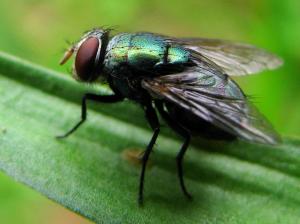Blowfly maggots provide physical evidence for forensic cases

Chrysomya megacephala - a common blowfly in Malaysia
Estimation of the post mortem interval (PMI) is one of the most crucial matters in autopsies and entomological specimens have been widely used to determine PMI after 72 hours of death. This is done using the oldest blowfly larvae found and from the succession pattern of insects that colonize the dead remains. Thus, the use of blowflies in forensic cases are crucial.
The most common blowflies in Malaysia are Chrysomya megacephala and Aechotandrus rufifacies. Blowflies arrive and deposit their eggs on a dead body within minutes of death occuring as the odour released from the carcass attracts them.
The eggs then grow to feeding larvae, which feed on the dead remains until they reach maturity. Larvae that feed on the tissues of an individual who took drugs or was poisoned will ingest these substances as well as their metabolites, proving that the drugs had accumulated in the body.
Some criminal cases involve the use of firearms. The forensic investigation of such cases requires physical evidence to be collected at the scene of the crime. In extreme conditions, when the bullet case is not found and the dead body is actively decomposing, blowfly maggots obtained from the dead remains hold potential clues in aiding the forensic investigation.
Our laboratory studied the presence of several different types of toxins, including malathion, paraquat, gasoline, paracetamol and ketum extracts, along with gunshot residue (GSR), to determine the effects of these toxins and GSR in the development rates of the blowfly species, Chrysomya megacephala and Aechotandrus rufifacies. Our aim was to determine whether the presence of toxins may affect the estimation of PMI. We were also exploring the potential of blowfly samples to be applied in forensic investigations for detecting toxins and GSR.
Our results showed that the presence of malathion, paraquat, gasoline, paracetamol, ketum extracts and GSR affected the development rates of blowflies. In real intoxication and shooting cases involving decomposed remains, estimation of the correct PMI using larvae samples should consider the delayed and accelerated duration on the development of the blowflies. We also found the presence of active components of toxins in the blowfly samples we studied, proving the potential of blowfly samples to be tested in investigations to identify toxins in the victim’s body.
In conclusion, the blowfly species, C. megacephala and A. rufifacies, can provide crucial and important physical evidence in forensic investigations.
For further information contact
Rumiza Abd Rashid
Faculty of Applied Science
University Teknologi MARA
Malaysia
Email: rumiza9550@salam.uitm.edu.my
Media Contact
All latest news from the category: Life Sciences and Chemistry
Articles and reports from the Life Sciences and chemistry area deal with applied and basic research into modern biology, chemistry and human medicine.
Valuable information can be found on a range of life sciences fields including bacteriology, biochemistry, bionics, bioinformatics, biophysics, biotechnology, genetics, geobotany, human biology, marine biology, microbiology, molecular biology, cellular biology, zoology, bioinorganic chemistry, microchemistry and environmental chemistry.
Newest articles

Bringing bio-inspired robots to life
Nebraska researcher Eric Markvicka gets NSF CAREER Award to pursue manufacture of novel materials for soft robotics and stretchable electronics. Engineers are increasingly eager to develop robots that mimic the…

Bella moths use poison to attract mates
Scientists are closer to finding out how. Pyrrolizidine alkaloids are as bitter and toxic as they are hard to pronounce. They’re produced by several different types of plants and are…

AI tool creates ‘synthetic’ images of cells
…for enhanced microscopy analysis. Observing individual cells through microscopes can reveal a range of important cell biological phenomena that frequently play a role in human diseases, but the process of…





















